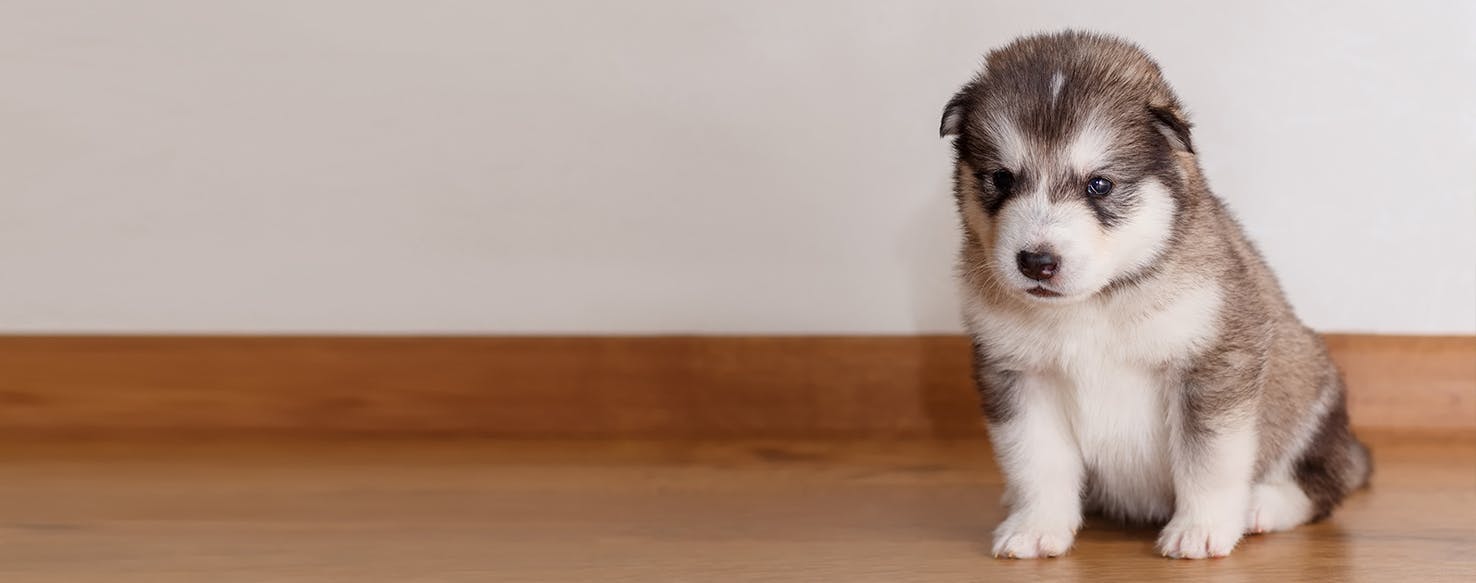- Home
- The Daily Wag!
- Behavior
- Why Dogs Don't Like Hardwood Floors

Common
Normal
If you have a dog and hardwood floors, you might have noticed that your dog has a particularly difficult time keeping traction on slick surfaces. Running around the house may even result in some collisions, slips, and falls. There are plenty of videos online of puppies and excited dogs peeling out on slick floors. When you have a new dog or new floors, you might have to struggle through a lengthy adjustment period or do something to help your dog better navigate your house. Some dogs may even fear hard floors and refuse to walk on them. What can you do about your slippery floors or nervous pup?
Dogs’ paws were meant for soil. They have claws, just like cats and other animals that they use for added traction when walking. Their toes flex and their nails dig in with each step. But with a hard floor, they’re unable to dig in with those toenails and get a grip. One reason why your dog might be uncertain about traversing hard floors may just be their paws in general. Dogs with longer hair may have fur obstructing or covering their feet, which makes walking more difficult. Longer nails will also impact your dog’s ability to walk on hard floors. And lastly, dogs get dry skin the same way that humans do. When your dog has dry, cracked pads, it makes slipping more likely. If you have a new dog who’s wary of your slick floors, it may be because they weren’t exposed to different floor surfaces in their crucial early age. This is especially true for rescue dogs. If you adopt an adult dog and they behave strangely on hard floors, it may just be that they’ve never encountered them before.
Things like manhole covers or sewer grates may trip up
a dog walking in the city, and laminate, vinyl, tile, or wood floors may be
disconcerting for a dog who has never had to walk on them before. Alternatively
and unpleasantly, if a new rescue dog seems stressed or afraid to walk on your
floors, it may be because they were punished for walking in a certain area,
like the kitchen, and associate the floor type with previous bad experiences. Older dogs can also injure themselves by falling. They may feel
insecure walking on slippery surfaces because they either have already fallen
or don’t have confidence in their ability to walk across a slick floor.
Especially for an old dog with arthritis or existing health issues, a bad fall
can result in more than bruises—some injuries could require costly surgeries to
repair.
Need advice about your pet's health?
Get answers fast from a veterinary professional 24/7 in the Wag! App.
Get Vet ChatWhat can you do for your fearful Fido? If your dog is simply afraid of falling or slipping on hard floors, you can purchase several options that may help your dog cope with the new flooring type. Traction booties for dogs may help them overcome their fear of walking across the slippery floor. There are also other devices that can be adhered to your dog’s pads or attached to their nails to improve their stability when walking. Alternately, you can purchase traction mats or area rugs to help your dog traverse your home. Especially where your dog tends to nap and sleep, getting up from a slick floor can be difficult, especially for older dogs.
Keeping your dog’s nails trimmed frequently and clipping the hair between their pads will also help reduce slipping. If you can’t clip your dog’s nails yourself, you can take them to a groomer and even some vets for a minimal cost. Having more of their pads directly on the floor will help improve traction. And if you can improve the hydration on your dog’s pads, you will also help improve their grip. There are natural products available that help restore dry, cracked paws. If you have a new dog or new floors, you can also try to train your dog to become comfortable with the surface. Enticing your dog to explore by placing treats out of reach should encourage your dog to walk. And a dog who realizes walking across your floor will result in goodies, they may be less reluctant to try it out.
If your dog suddenly and inexplicably starts exhibiting fear or aggression, you should make sure there’s nothing else going on with your dog medically. Have them checked out by a vet. Some problems, like thyroid dysfunction, may be linked with sudden behavior changes. In elderly dogs, sudden changes in their surroundings or routine may be harder to adapt to than for younger dogs. Older dogs who suddenly begin losing their eyesight may also develop sudden fear or hostility because they’re confused and feeling insecure. Ruling out medical problems should be a first step in addressing your dog’s sudden fear of walking on hard surfaces. You should also do your part to ensure your dog doesn’t have to be nervous or uncomfortable in your home. Using booties or rugs is a great way to keep up your dog’s confidence.
Whether you have a new dog, new floors, or an elderly dog who is afraid of falling, you should make sure to do your part as a responsible pet owner to make them more comfortable. You can either provide rugs or booties or get area rugs to make sure your dog can walk safely in their home. It is your duty to ensure that your dog gets a grip.
Written by a Border Collie lover Charlotte Perez
Veterinary reviewed by:
Published: 03/13/2018, edited: 01/30/2020
More articles by Charlotte Perez

